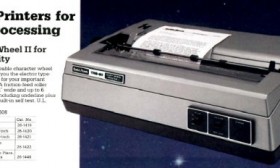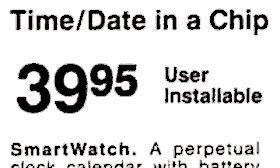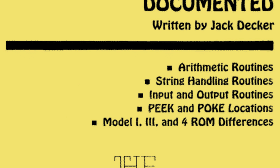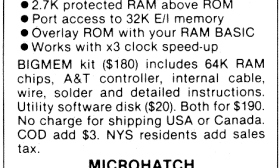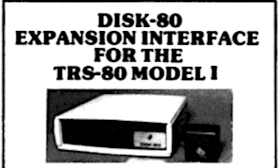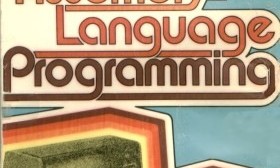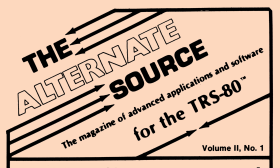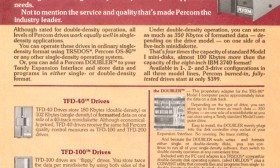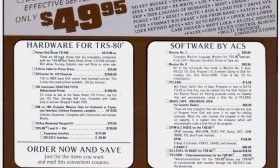The Daisy Wheel Printer II (catalog number 26-1158), more commonly known as the Daisy Wheel II, DW II, or DWP II, was the highest quality TRS-80 printer that Radio Shack sold. It was introduced in 1980 for a price of $1,960.00, although that was later raised to $1,995.00. Radio Shack featured the Daisy Wheel II in their catalog from 1981 to 1984 as their “best high-speed, formed-character printer.”
The Daisy Wheel II was a replacement for the rarely remembered Daisy Wheel Printer I (catalog number 26-1157), which was described by Ed Juge this way:
(Read more...)
The SmartWatch was a single-chip clock/calendar add-on that could be used by many computers, including the TRS-80 Model I, III, and 4. The SmartWatch chip, a Dallas Semiconductor DS1216E, worked by replacing a 28-pin ROM and plugging the chip into its socket. Installation varied depending on the computer, but the general steps were simple:
(Read more...)
Understanding how to use TRS-80 ROM routines was very important for any TRS-80 Model I or III programmer, and there were many books written about that subject. TRS-80 ROM Routines Documented by Jack Decker was considered to be one of the best. Jack Decker wrote many articles for The Alternate Source, including a series named “TRS-80 ROM Routines Documented,” which served as the basis for this book.
The bulk of TRS-80 ROM Routines Documented is composed of five chapters detailing various portion of the TRS-80 ROM:
(Read more...)
BIGMEM was a modification for the TRS-80 Model I which increased available memory. It was introduced by Microhatch in early 1982 for $180.00, but the price was reduced to $169.00 by late 1983. Microhatch also sold a utility disk (with print spooler) for $20.00 which could be bundled with BIGMEM. For any user unwilling to perform the modification, Microhatch would install BIGMEM for $199.00.
Much like the Holmes Internal Memory, BIGMEM replaced the 16K RAM chips inside the Model I with higher-capacity 64K chips. This avoided the reliability problems of the external memory in an Expansion Interface and also worked better with most speed-up kits.
(Read more...)
The Disk-80 was an alternative to the Radio Shack Expansion Interface that was sold by Micromint Inc. It was designed by Steve Ciarcia and was featured in his “Ciarcia’s Circuit Cellar” column in the March 1981 issue of Byte.
The Disk-80 was sold in several configurations:
(Read more...)
At one time in the TRS-80 world, the name William Barden was linked to assembly language programming. This book was one of the main reasons why.
TRS-80 Assembly Language Programming, along with
Programming the Z80 by Rodney Zaks, helped introduce a whole generation of TRS-80 programmers to assembly language.
(Read more...)
The Alternate Source, also known as The Alternate Source Programmer’s Journal or TAS, was a well-remembered and very technical TRS-80 publication. Later billed as “The magazine of advanced applications and software for the TRS-80,” the first issue was published by Joni Kosloski and Charley Butler in January 1980. It was published once every two months for a total of six issues a year.
The concept behind The Alternate Source originated in October 1979. The Alternate Source was also the name of a company run by Butler and Kosloski that sold TRS-80 books and software. TASMON (The Alternate Source Monitor) was one of their more popular software packages. They also sold The Alternate Source in book form, with each year’s issues collected into one volume.
(Read more...)
Computer User was a short-lived TRS-80 magazine created by the publishers of Interface Age, a popular computer magazine that began in 1976.
Unlike many other TRS-80 magazines, Computer User was a professional, glossy publication from its first issue in November 1983. It was heavily promoted, with promotional copies of the premiere issue sent to subscribers of competing magazines.
(Read more...)
The Percom Doubler was the first successful double-density add-on for the TRS-80 Model I. It was introduced in 1980 by Percom Data Company for an initial price of $219.95. The Doubler hardware was designed by Wayne Smith and Harold Mauch (president of Percom) and the accompanying software was written by Jim Stutsman.
(Read more...)
VTOS (which stood for “
Virtual
Technology’s
Operating
System”) was the second TRS-80 Model I operating system created by Randy Cook, the author of Model I TRSDOS. VTOS was released in 1979 and sold through Randy Cook’s company, Virtual Technology Inc. The original price was $49.95 for VTOS version 3.0. That was increased to $99.95 for version 4.0, or $125.00 for VTOS plus Operator’s Guide and Master Reference manual. There doesn’t appear to have been a Model III version of VTOS.
(Read more...)
